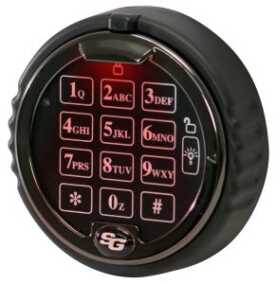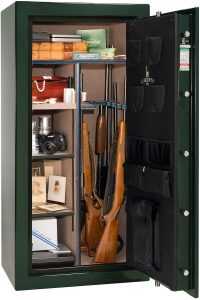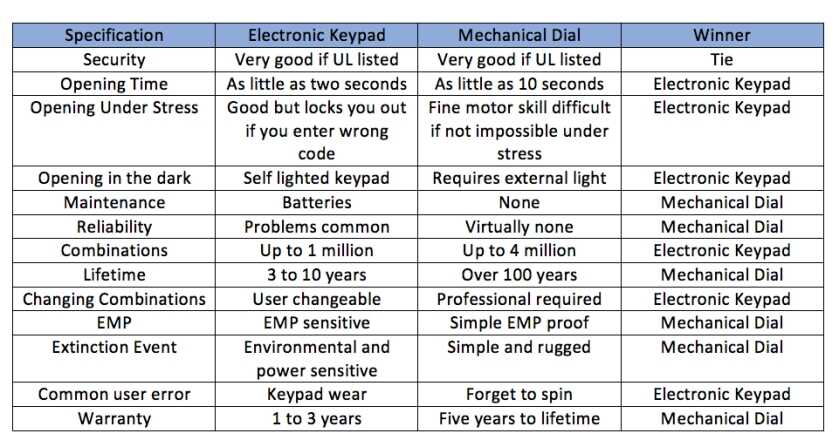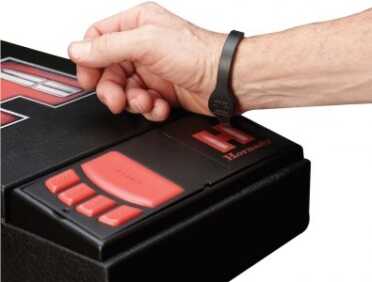

Editor’s Note: This is the second installment in a series about home gun safes. The series will dive into detail about safe technology, mounting/hardening you safe, increased fire protection, specialty safes and higher-rated safes, and buying used safes. There is a lot of information to consider when buying a safe. Follow along with us as we take a deep dive into this subject.
Series:
- Part 1: Introduction to Gun Safes
- Part 2: Electronic/Biometric/Manual Locks
- Part 3: Anchoring Your Safe
- Part 4: Fireproofing Your Gun Safe
- Part 5: Understanding The Threats
- Part 6: Specialty Safes & Remodels
- Part 7: Quick-Access Safes
- Part 8: Buying & Selling Used Safes
- Part 9: Moisture, the Constant Battle
Within gun culture exist a few topics of debate that will probably never be decided. The classic 9 mm versus .45 ACP, appendix carry, Glock versus 1911, and recently, electronic versus combination locks for your gun safe. As in all of these other debates, this choice involves many differing opinions. In fact, there may not be one strictly correct answer; each lock has its own pros and cons, and you have to decide which factors are most important to you.
I will offer one of my maxims that I try to live by when I select gear: “There is possible and there is probable. Possible means that could it happen, no matter how unlikely. Probable means that I should be expecting it and thankful if it doesn’t happen. I have no problem with covering the possible as long as the probable is taken care of first.”
UL Rating

To be UL-rated, a lock much have at least one million possible combinations available. Images courtesy of manufacturers.
Underwriter Laboratories has a standard UL 768 that it certifies both mechanical dial and electronic keypad locks. This standard requires at least 1 million different possible combinations. Simply put, the dial must have numbers from 0 to 99 and must use three different numbers. UL 768 also requires that the dial must be able to accurately select the exact number being entered; close is not good enough when dialing a combination.
This standard also specifies that the lock bolt must be immobilized by mechanical means if the lock is punched. The lock must successfully stand up to 20 hours of attempts to open by someone who does not know the combination. This 20-hour test includes walking the tumblers, feeling the tumbler gates, sighting variations on the dial and expert manipulation techniques.
There is an additional specification of UL 768 Group 1R that includes everything above, but adds the requirement that the lock withstand a radiological attack for 20 hours from a radioactive source not exceeding the equivalent of 10 curies of cobalt-60 at a 30″ (762 mm) distance. This requirement was primarily developed for locks with plastic pieces to avoid the lock being x-rayed, not EMP. You will probably not find this in a gun safe lock, as most gun safes use all metal parts.
Keep in mind that the above requirements were developed for mechanical combination locks and not all of them will applied to electronic locks.
You should be very concerned when considering purchasing a gun safe with an unrated lock. If the manufacturer’s chosen to save a few bucks by going this route, there are plenty of potential perils on the table. One may be able to simply remove the keypad entirely and short across the wires to trigger the mechanism—a simple task for the common crook. Even easier, one may even be able to just punch the lock and open the safe. If your lock is unrated and it malfunctions, be prepared to either destroy the safe or pay a locksmith by the hour to attempt to open it. I would encourage you to view some of the videos on the Internet of children breaking in to these cheap locks.
Electronic Locks

An electronic lock features a keypad like that on your phone. This one also has a mechanical dial around the keypad.
Electronic locks have a keypad reminiscent of the one on your telephone, with numbers and letters. There is a sequence that must be correctly entered that can also include * and #. When the combination is entered correctly, a servo is activated that releases the lock. A variety of things can happen when the combo is entered incorrectly. The lock may simply refuse to open, a time delay can be activated to deny input, an alarm may be triggered or access may be denied permanently.
One of the distinct advantages of an electronic lock is the ability to have multiple user-changeable combinations. This affords you the opportunity to grant or revoke access to your safe to others as needed—an impossibility with mechanical dial locks. Electronic locks also tend to be faster to operate both on an everyday basis and under adverse conditions, such as stress or low light.
Electronic locks have their own unique disadvantages as well. They require electricity, generally provided by batteries. They have electronics and wiring that are subject to their own random and catastrophic failure through no particular outside event. They can fail when exposed to humidity and water, heat and flames.
The lifespan of an electronic lock can be measured this way: most electronic locks will not live past 15 years. The average lifespan of an electronic lock is six to eight years with average use. You may even experience an early mortality of just months. When the actual lock inside the safe fails, you’ll probably be paying a gunsmith to drill in.

If you do not properly maintain your lock, you might have to get a locksmith to come open your safe.
Maintenance of an electronic lock is critical. Most of the locks use a 9V battery, and I recommend changing them when you change the batteries in your smoke alarms. The keypad that is mounted on the outside of your safe is nothing more than a transmitter to the actual lock on the inside of the safe. Over a period of years, the keypad will begin to develop wear and tear on the keys that you push most frequently. This will definitely telegraph to a thief what numbers need to be pressed. The keypad should be replaced as soon as these patterns begin to develop. The actual lock on the inside of the safe should probably come with it expiration date of five years from the date of purchase. If you’re willing to invest in a five-year replacement plan, you can probably avoid paying big money to get back in your safe at the hands of your friendly neighborhood locksmith.
Warranties on electronic locks generally run one to three years. Keep in mind that the warranty begins from the date of manufacture, not the date of purchase.
Mechanical Dial Locks
Mechanical dial locks have been around in their present form since the early 1900s. This is a debug technology. Most gun safe mechanical locks have a dial that turns clockwise then counterclockwise, and will open after a three-digit combination has been entered. The lock has three internal discs which are all connected either directly or indirectly to the combination dial on the outside of the safe. The third and final disc is generally connected to the dial on the outside of the safe directly, and when the other two discs are in the correct position it will open the lock.
What makes these locks so effective is that they are mechanical parts with a long lifespan, being free of batteries and electronics. They afford anytime access with the proper code. They are typically not as sensitive to adverse conditions such as short-term exposure to moisture, heat, or water. They will always stand up better to fire than an electronic lock will.
As a product of 100-year-old technology, they definitely have some reliability advantages; but rest assured, you do give up some modern conveniences that are nice to have. If you close the door but failed to spin the dial, your safe is not locked. It typically requires four times longer to open a combination lock than an electronic keypad. Add some stress to the mix and it can seem to be impossible to open. The combination is typically more difficult to remember than a short string of keystrokes. If you have to change the combination of your safe after giving it to someone else, you will have to meet and pay your local locksmith.
Maintenance on a mechanical dial lock is relatively simple. The tumblers may require some minor lubrication, and that’s about it. Even without any maintenance at all, a mechanical lock will almost always outlast an electronic lock; with a small amount of maintenance, a high-quality mechanical lock will outlast your grandchildren.
Warranties for mechanical locks are much better than electronic locks; the standard is five years but many of them have a lifetime warranty. Manufacturers can give these warranties out more easily, since a mechanical lock will rarely ever fail.
Biometric & RFID
Biometric locks use a physical or behavioral characteristic to identify a person. This can include fingerprints, iris structure, hand geometry, facial recognition, eye retina, and even your blood vessels. The pinnacle of this technology is the eye retinal scanner.
Roughly half the people in America today have a smart phone with a biometric device for unlocking it. Most of these are some form of fingerprint reader. The idea of letting something unique about you open your safe is appealing to all of us. This stops unauthorized access, and prevents us from losing a combination or a key. But like most things in life, these conveniences are only worth so much and there’s always a catch. A true military-grade biometric reader will cost somewhere around $5,000. A decent commercial-grade biometric reader is going to be around $1,000. These prices are coming down, but to most of us the juice is just not worth the squeeze.
There are two other potential problems with biometrics. The first problem is that typically the reader we get on these safes is not really a reader so much as a scanner that compares the fingerprint to a picture. What’s the margin for error here? This leads to a whole new set of problems: How close is close enough, and how many people are going to fall into the “close enough” category? The answer is: more than you would think. What if you damage your finger on a hot pan or while fighting with an intruder, and the image doesn’t match? No gun for you! The second primary issue is that most of these fingerprint readers are strapped to cheap, poorly designed and built pistol safes. These junk safes can sometimes be defeated with something as simple as a paperclip. So, if you go this route, make sure you buy a quality product.
RFID stands for radio frequency identification, which is used in all sorts of applications, especially the supply chains of most manufacturers and retailers. The RFID safes work much the same way as the biometric safes do, in that they are broadcasting a signal and looking for that unique code to be bounced back to them from the RFID chip. Once that signal is received the safe opens. This provides quick access to the person who has the RFID chip, which can be embedded in a bracelet, key fob or a card. Unlike biometric locks, you can hand someone your card give them temporary access if needed.
[one_half]
[/one_half]
[one_half_last]
[/one_half_last]
If you’ve ever used one of those cards that you can swipe through a turnstile or to access a building, then you’ve used RFID. Next time you buy something for $50.00 or more at a chain store, take a look and see if you can find a little white plastic sticker on the inside of the box, opposite the barcode on the outside of the box. That is an RFID tag that is used to detect theft.
RFID has some very unique problems as well. It is dependent on the safe broadcasting a signal that will activate the chip and reflect back the correct signal. If the chip is damaged or shielded, that signal will never come to open the safe even though you’re holding the key. Like biometric, RFID also suffers from a proliferation of junk on the market, primarily bad safes with RFID attached to them. Finally, it is possible to read the chip, clone it and then open the safe.
The Much-Feared EMP
An electromagnetic pulse (EMP) comes in two forms: natural and man-made. A natural EMP that most of us are familiar with would be a lightning bolt. Man-made EMPs wound include nuclear events or electronic pulses designed to replicate one. Both of these can be equally harmful to an un-shielded electronic device such as an electronic lock. There are really three technologies that can deal with an EMP event: mechanical locks, Liberty Safe’s electronic locks, and the electronic mechanical method. Mechanical locks have no electronics to harm—simple fix. Liberty Safe’s electronic locks are now certified to withstand an EMP event, which is achieved by shielding the electronics. The electronic mechanical method involves the use of redundant locks—one mechanical and one electronic. Either one can independently unlock the door.
Let’s face it, if we have a major EMP event, you’re going to want quick and reliable access to your guns…
Puts and Checks
Rather than making a recommendation for you, I’ve summarized some of the key details in the chart below.








Hi JON HODOWAY, please suggest me Buying biometric or Combination lock. Will you tell me what kind of safe will be best for my A-r Rifle? I have a Stack-on 4122 that isn’t capable to store the rifle.
Some one suggest me Buying biometric or Combination lock. Will you tell me what kind of safe will be best for my A-r Rifle? I have a Stack-on 4122 that isn’t capable to store the rifle.
I don’t say its a great Article But Its create some hope ? Will you tell me what kind of safe will be best for my A-r Rifle? Some one suggest me Buying Fireproof or Combination lock. thanks
I have a GunVault MV500 Microvault Pistol Gun Safe which batteries system but it doesn’t work openly perfect.
My S&G digital keypad lock just went bad. It started being a bit balky (would not open right away, and then begin failing to lock when closed) a few months ago, so I started to heed these signs. No where in the Cannon instructions were any admonishments to sit up and take notice before the lock quit working, which it did after I kept the safe door open and kept attempting to function cycle the lock.
I bought this safe in 2010 from Costco.
I called Cannon and the best they could offer me was a NL digital lock from a company known as LP as a warranty replacement. Cannon could not/or refused to match the brass color of the original turning stem and locking handles.
What I got was a lockbox that is half the size of the original S&G swinglock box and a very flimsy and featherweight plastic keypad.
In fairness, it all installed OK except I will need to tap some threads on the horizontal holes in the safe door as the replacement does not use the vertical holes that the S&G locks do. The miniature lockbox seems to work OK, but I am not sure it is UL rated nor does it inspire an confidence in its reliability.
Bottom line, DO NOT BUY a Cannon safe equipped with a digital LM/LP lock to protect your valuables. Instead, buy a S&G Titan or Spartan digital lock with the D-Drive lock box. These digital locks have certified to have passed a series of EMP events and continue to work. The D-Drive is a deadbolt that is mechanically raised to unlock the safe by turning the outer ring of the digital keypad after you enter the digital code which unlocks and allows you to physically rotate the outer ring to raise the deadbolt, thus freeing the locking mechanism to open the safe. The re-locker function is maintained as well.
Based on my experiences with Cannon, they have taken a huge turn to get cheapen their products. If you buy from them, you will regret not doing your homework to see that they are to be avoided, especially when there are plenty of choices of safes built by folks who remain committed to providing real lifetime quality and warranty in their safes.
I have a Canon with an electronic keypad. Is there a conversion available to a mechanical dial?
The S & G (Sergeant & Greenleaf) mechanical four digit combination lock on my safe hasn’t failed since I first used it in 1998 or 1999. They set the standard, and essentially the same as the S & G combination locks I went to school on for my classified material custodian training except for the armored box military locks are in.
Check out the 2 part article in buying safes
this is a good article.
however,2 lock options were not mentioned…..
1) key operated U.L. rated safe lock
2) redundant safe lock
one can research the key-op safe locks at the lock manufacturer websites
S&G 6804
S&G FAS
LAGARD 2270
a redundant lock combines a mechanical safe lock
with an electronic safe lock.
the electronics are used for convenience…..
when the electronics fail,the mechanical lock is used
to open the safe,negating the need for a safecracker
to open the safe.
one can research these by search engine…..
redundant safe lock
answer for Keith:
there are 2 misprints…..
a 3 tumbler mechanical safe lock,with a 100# dial,
has 1,000,000 theoretical combinations…..
a 4 tumbler mechanical safe lock,with a 100# dial,
has 100,000,000 theoretical combinations…..
the 4,000,000 number is misprint/misinformation
a U.L. rated TYPE 1 electronic safe lock is required
to have a minimum of 1,000,000 combinations
the 1,000,000 electronic safe lock combinations is the winner
because all combinations are useable.
you will notice that I stated theoretical combinations
for the mechanical safe locks.a large portion (200,000+)
of the combinations ARE NOT useable,because of certain
mechanical features of the locks
Referring to the summary chart, why is one million combinations on an electronic keypad the winner over four million possible combinations on a mechanical dial? Is one of the quantities of possible combinations off, the wrong winner listed, or the extra three million combinations too much of a good thing?